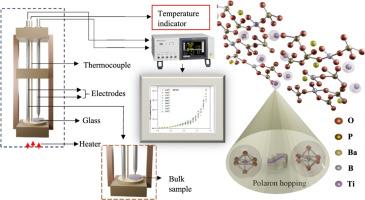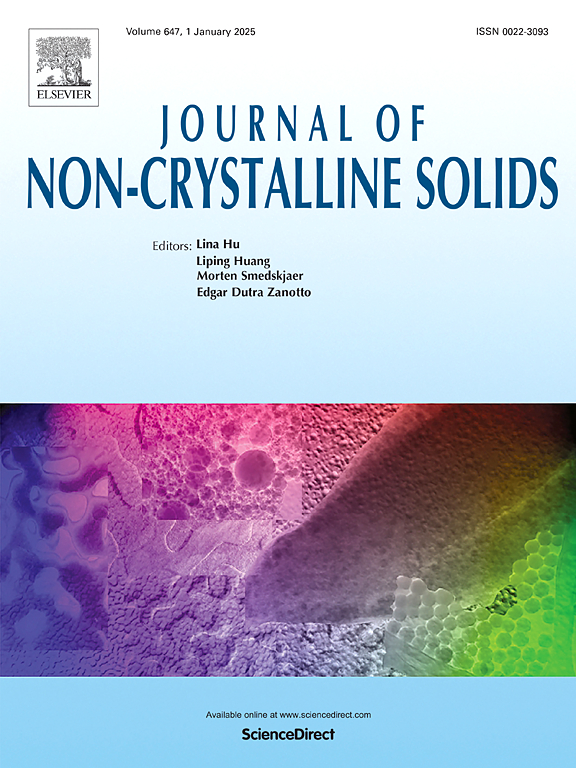Influence of titanium redox states on luminescence and conductivity in TiO2 -doped borophosphate glass system
IF 3.2
3区 材料科学
Q1 MATERIALS SCIENCE, CERAMICS
引用次数: 0
Abstract
Borophosphate glasses have garnered significant interest due to their potential for optical and electronic applications. This research delves into the luminescent and conductive properties of 40P2O5–25B2O3-(35-x) BaO-xTiO2 (x = 0–5 mol%) glasses synthesized via the melt-quench method. The glass doped with 4 mol% TiO2 exhibited intense luminescence within the 400–600 nm spectrum, manifesting as a vivid blue emission and the highest Ti3+ ion concentration. Beyond this threshold, the luminescence intensity waned, highlighting the significance of Ti4+/Ti3+ ratios. Absorption spectra and X-ray photoelectron spectroscopy were utilized to study these multivalent ions. Temperature-dependent AC conductivity, exhibited a linear increase, consistent with the Correlated Barrier Hopping (CBH) model. Enhanced polaron hopping between Ti3+ and Ti4+ with increasing TiO2 content improved the dielectric constant and conductivity, peaking at 4.145×10−5 Scm−1 at 5 mol% TiO2 within the 450–530 °C range. These findings underscore the tunability of TiO2-doped glasses for optoelectronic applications.

掺杂硼磷酸盐的二氧化钛玻璃体系中钛氧化还原态对发光和导电性的影响
硼磷酸盐玻璃因其在光学和电子应用方面的潜力而备受关注。本研究深入探讨了通过熔融淬火法合成的 40P2O5-25B2O3-(35-x) BaO-xTiO2 (x = 0-5 mol%)玻璃的发光和导电特性。掺杂了 4 摩尔% TiO2 的玻璃在 400-600 纳米光谱范围内呈现出强烈的发光,表现为鲜艳的蓝色发射和最高的 Ti3+ 离子浓度。超过这一阈值后,发光强度减弱,这突出了 Ti4+/Ti3+ 比率的重要性。我们利用吸收光谱和 X 射线光电子能谱来研究这些多价离子。与温度相关的交流电导率呈线性增长,与相关势垒跳变(CBH)模型一致。随着 TiO2 含量的增加,Ti3+ 和 Ti4+ 之间的极子跳动增强,介电常数和电导率得到改善,在 450-530 °C 范围内,当 TiO2 含量为 5 摩尔时,峰值为 4.145×10-5 Scm-1。这些发现强调了掺杂 TiO2 的玻璃在光电应用中的可调性。
本文章由计算机程序翻译,如有差异,请以英文原文为准。
求助全文
约1分钟内获得全文
求助全文
来源期刊

Journal of Non-crystalline Solids
工程技术-材料科学:硅酸盐
CiteScore
6.50
自引率
11.40%
发文量
576
审稿时长
35 days
期刊介绍:
The Journal of Non-Crystalline Solids publishes review articles, research papers, and Letters to the Editor on amorphous and glassy materials, including inorganic, organic, polymeric, hybrid and metallic systems. Papers on partially glassy materials, such as glass-ceramics and glass-matrix composites, and papers involving the liquid state are also included in so far as the properties of the liquid are relevant for the formation of the solid.
In all cases the papers must demonstrate both novelty and importance to the field, by way of significant advances in understanding or application of non-crystalline solids; in the case of Letters, a compelling case must also be made for expedited handling.
 求助内容:
求助内容: 应助结果提醒方式:
应助结果提醒方式:


